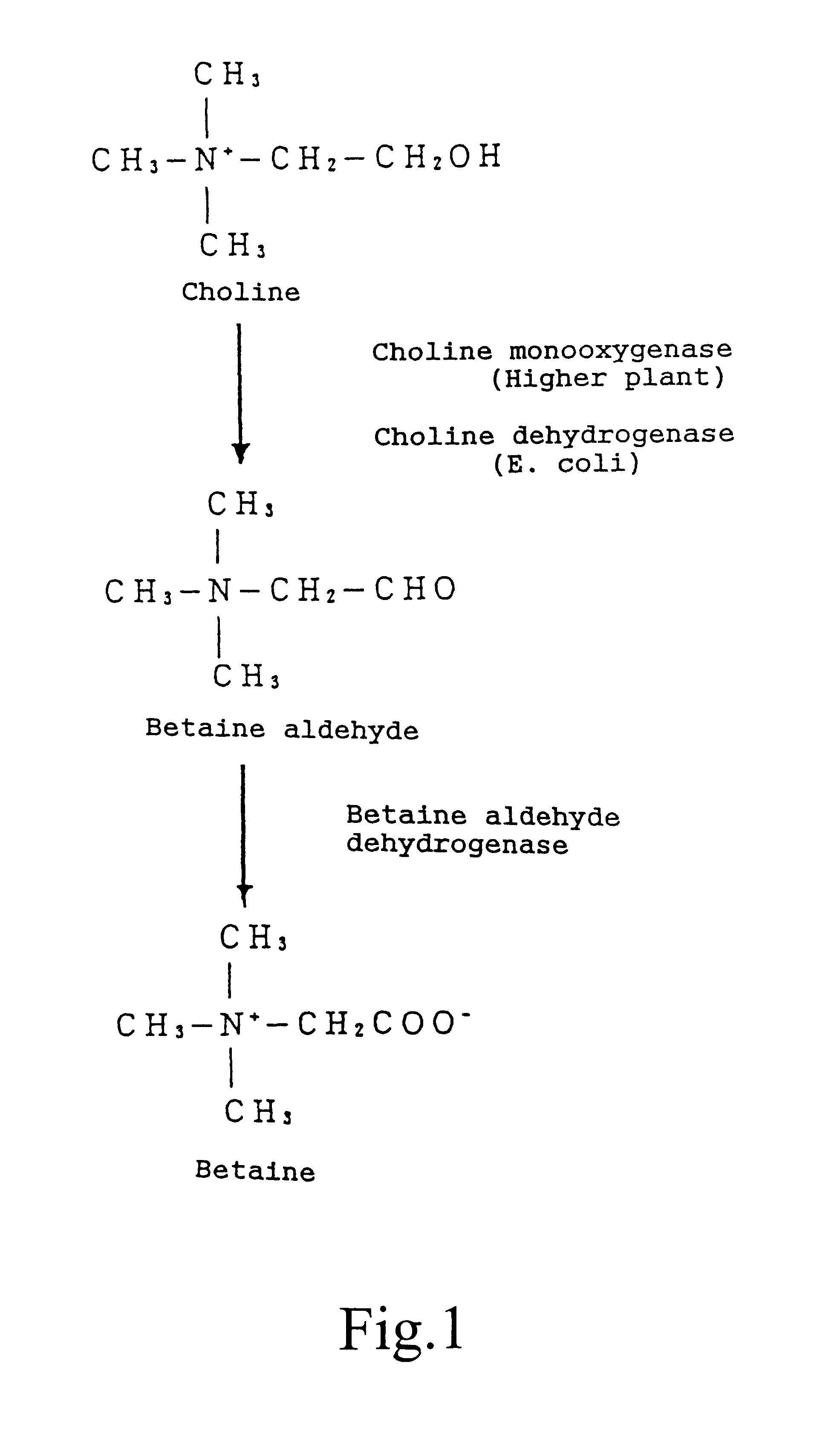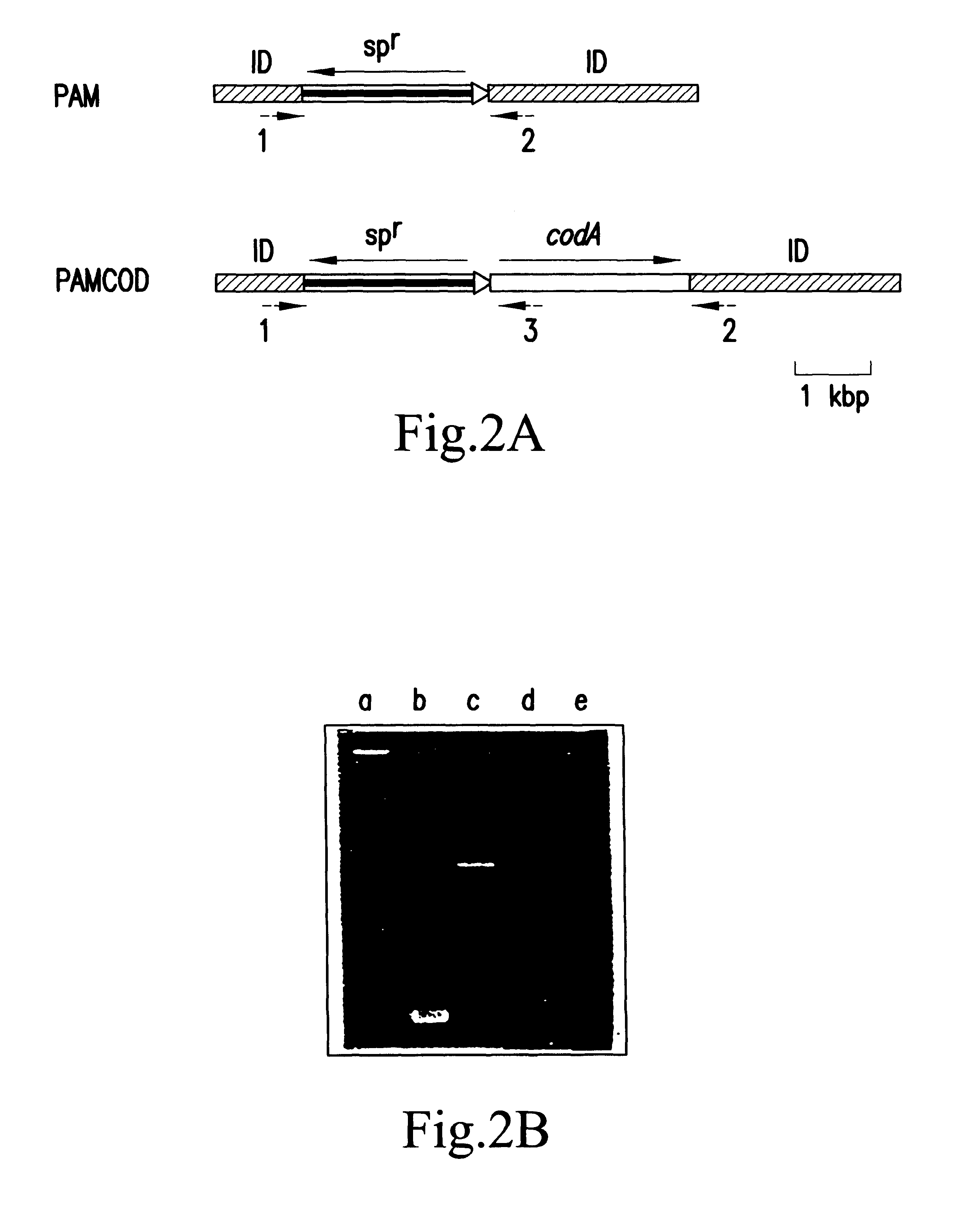Method for producing temperature-tolerant plants
a technology of temperature tolerance and plant, applied in the direction of oxidoreductases, biochemistry apparatus and processes, enzymes, etc., can solve the problems of not exclusively synthesizing betaine in cells, no report has shown, and betaine confers temperature tolerance on plants or bacteria
- Summary
- Abstract
- Description
- Claims
- Application Information
AI Technical Summary
Problems solved by technology
Method used
Image
Examples
example 1
Transformation of the Cyanobacterium Synechococcus PCC7942 With the CodA Gene
The choline oxidase gene was isolated from Arthrobacter globiformis by the method described in the Abstracts of Oral Reports published in the 34th symposium of the annual meeting of the Japanese Society of Plant Physiologists, 1994. In brief, 1) choline oxidase is fragmented with cyanogen bromide, 2) the N-terminal amino acid sequence of an appropriate fragment is determined, 3) appropriate portions are selected from said amino acid partial sequence to synthesize oligonucleotides corresponding thereto, 4) a partial sequence of the choline oxidase gene is amplified by PCR (Polymerase Chain Reaction) using these oligonucleotides as primers, 5) the amplified partial sequence of the choline oxidase gene is used as a probe to screen the genomic DNA library of Arthrobacter globiformis.
Thus obtained positive clones were subcloned into the plasmid pBluescript (SK.sup.+) (Stratagene) to i...
example 2
Confirmation of the gene Inserted Into Transformants
DNAs from the strains of wild-type, PAM and PAMCOD of Synechococcus PCC7942 were used as templates for PCR, and the amplified products were analyzed by SDS-PAGE. The results are shown in FIG. 2B.
PCR of DNA from the wild-type strain produced an amplified product of about 400 bp (FIG. 2B, lane b). PCR using DNA from the strain PAM as a template produced a band of about 2.4 kb, indicating that pAM1044 had been inserted into chromosomes. The band of about 400 bp as observed in the wild-type strain does not exist, indicating that native chromosomes had been completely replaced by mutant chromosomes in the strain PAM.
When DNA from PAMCOD was used as a template, the band corresponding to wild-type chromosomes was not observed (FIG. 2B, lane c). However, the predicted band of about 4.1 kb was not amplified, either, probably due to the large size of the insert and the high GC content in the codA sequence. Therefore, primer 3 corresponding t...
example 3
Expression of the CodA Gene in the Synechococcus Strain PAMCOD
The expression of the codA gene in the strain PAMCOD obtained in Example 1 was examined by Western blot analysis using a polyclonal antiserum to purified choline oxidase. The results are shown in FIG. 3. Signals were detected at 60 kDa in protein extracts from the strain PAMCOD (lane a) and purified choline oxidase (lane c). This signal was not detected in protein extracts from the strain PAM (lane b). This result confirmed that the codA gene had been expressed in Synechococcus PCC7942 under control of the conII promoter.
PUM
| Property | Measurement | Unit |
|---|---|---|
| Temperature | aaaaa | aaaaa |
Abstract
Description
Claims
Application Information
 Login to View More
Login to View More - Generate Ideas
- Intellectual Property
- Life Sciences
- Materials
- Tech Scout
- Unparalleled Data Quality
- Higher Quality Content
- 60% Fewer Hallucinations
Browse by: Latest US Patents, China's latest patents, Technical Efficacy Thesaurus, Application Domain, Technology Topic, Popular Technical Reports.
© 2025 PatSnap. All rights reserved.Legal|Privacy policy|Modern Slavery Act Transparency Statement|Sitemap|About US| Contact US: help@patsnap.com



